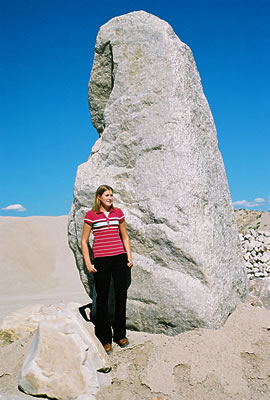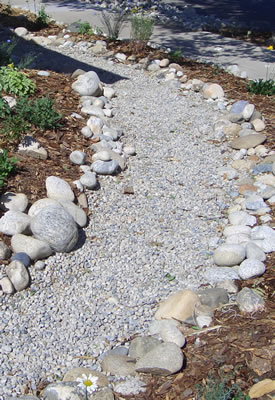Aggregate: Aggregates consist of crushed and sized rock (either quarried stone or crushed gravel) or natural sand and gravel, which are not crushed, but sized. Sand and gravel aggregate is less expensive than crushed stone aggregate, but crushed stone has the advantage of consistency.
Boulders: Individual natural river-rounded stones larger than 18” in diameter and ranging up to several yards in diameter. Depending on the scale of the landscaping project and the boulder size, these boulders may serve individually as points of interest among smaller features, or can be aligned or stacked to produce boundary markers, or retaining walls.

Centerpiece Boulder: A single, large boulder, usually a yard or more in diameter. These are often used as a visual focal point or centerpiece in larger scale landscape arrangements. They also work well to provide the foundation for small man-made hills or topography where the boulder may be exposed on one face and banked with soil on the other sides to produce a shaped slope. Centerpiece boulders may also be fitted together to produce large scale retaining walls.
Cobble Stone: Natural river-rounded stone ranging in size from 2” to 18” in diameter. Usually sorted into similar sizes, these rounded stones are the mainstay of landscape design. Innovative designers may also stack them or align them into low fences and boundary lines.
Cobblestone pavement: An historic or decorative method of paving streets or paths. To create cobblestone pavement, loose cobble stones are embedded in a matrix of sand or soil and tightly tamped in place. The cobbles are placed so that the tops are all at the same height and the sides are touching each other tightly.
Construction Aggregate: This is the sized, or crushed and sized, rock material used in a variety of construction products. Construction aggregates are used in concrete and asphalt which compose most of our streets and highways, bridges, houses and other buildings, wallboard, roofing, and other structural components. Aggregates range in size from large boulders (rip rap) used as fill in large construction projects to finely ground flour-sized particles used in paint, glass, plastic, medicine, agricultural feed and soil conditioners, and many other industrial and household products. Construction aggregates are also used in water purification, emissions control, soil erosion control, and other environmental improvement products.
Crushed Rock: Natural stone that has been mechanically crushed and sorted to produce sharp edged stone of uniform size. This material is typically used for walkways, paths, driveways, parking areas, and to highlight other landscape features such as Centerpiece boulders.
Decorative Aggregate: If the aggregate is selected because of its color or appearance, it is landscape or decorative aggregate. Decorative aggregates are often used in exposed concrete slabs where the color of the aggregate is important to the final appearance of the project. Where the color of the included stone could be distracting, a pale gray aggregate may be chosen for concrete with a uniform or neutral finished appearance.
Fines: Particles of rock and organic material smaller than “Sand.” In practice, fines are generally composed of clay formed by the natural break down of the softer rock minerals.
“Glacier White”: This is the trade name used by Butala for their very light colored natural granite stone. In “Glacier White” stone, the major feldspar component is white or very pale gray, and this yields a granite with a uniformly “white” color tone. Viewed closely, many gradations in crystal color from transparent colorless to white to pale gray are visible, as well as a scattering of dark flecks of mica.

Granite: A type of stone formed by the slow cooling or crystallization of melted rock. The three main components of granite are feldspar, quartz and mica. Feldspar has several different colors or forms, and is primarily responsible for the apparent over-all color of the granite. Quartz is clear and appears to take color from the feldspar and mica around it. Mica shows as black flecks and makes up less than 20 % of the components of a granite.
Hardscapes: Landscape materials with everything but the “green”. An excellent and attractive water saving landscaping technique.
Masonry Sand: A washed and sorted sand of very uniform and fine size appropriate for fine masonry and other hand-mixed concrete applications.
Natural Cobble: see “Cobble stone” above.
Natural Round Stone: Stone that has been naturally rounded by the action of water, ice, or the sediments and other stones carried by water or ice. Natural round stone is typically found along rivers, below glaciers, or in the geologic formations related to historic features of this type.
Pea-gravel: Natural round stone approximately the size of a pea, around ¼” to ½”. This fine round gravel is popular for paths and as contrast material for larger landscape features. Pea-gravel can be raked into patterns for ornamental gardens.
Retaining Wall: A vertical or nearly vertical structure serving to hold a potentially unstable area of soil in place. Retaining walls are also used as an attractive way to create a multi-level space.
Rip Rap: Any type of stone used to reinforce a slope. Rip-rap is generally used to protect slopes prone to river erosion, wave action, surface erosion, or wind damage. It is usually applied with larger stones at the base of the slope and in a layer one to several stones deep.
Screened or Sorted Rock: Any type of rock that has been sorted by size. In general, this is done using a mechanical screener where screens, each with a different grid size, and a series of conveyor belts are used to sort the rock by size.
“Starlight Bright”: This is the trade name used by Butala for their pure white marble stone. “Starlight Bright” is available only in rough (not rounded) chunks or as crushed stone.
Washed Sand: Sand which has been water-rinsed to remove particles of a smaller size. This creates a clean, dust free sand for which there are many uses.